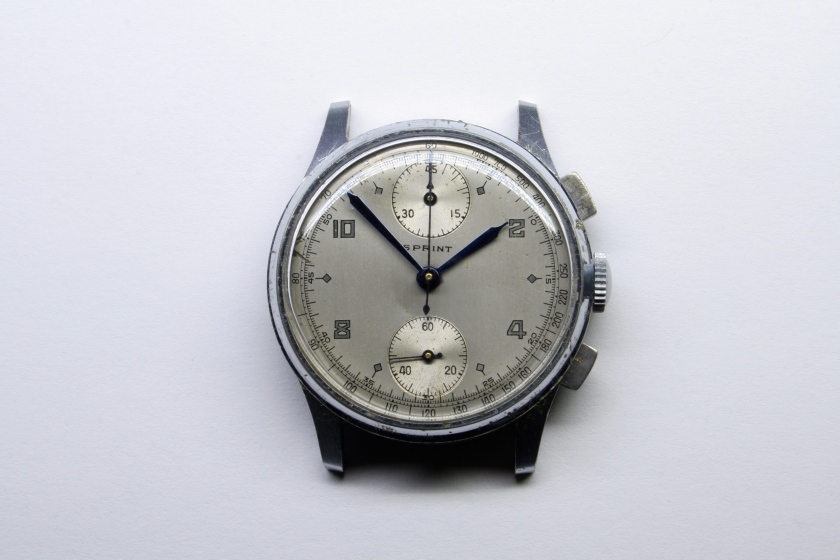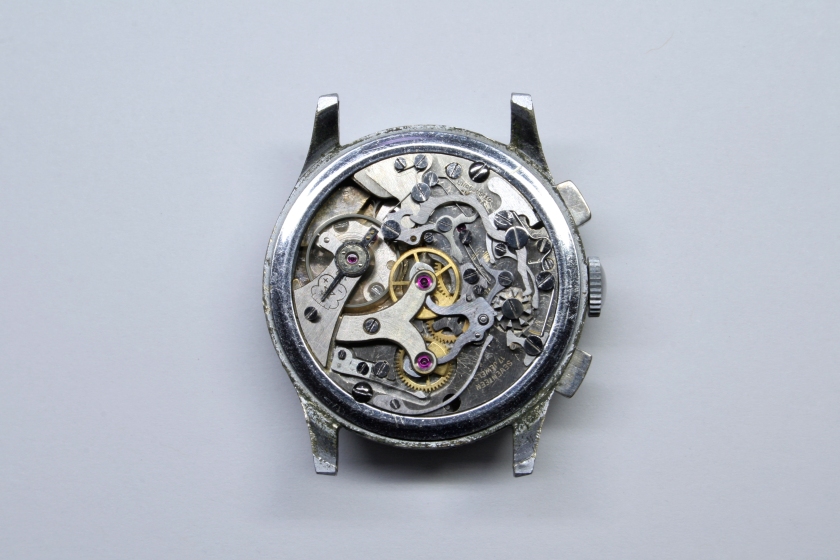This watch has been on and off of my workbench now for three years. In the beginning it was missing parts and that’s what kept it off the bench. Then it developed a problem which took forever to track down; I’d lose interest in fixing the piece and forget about it, then rediscover it at a later date. I have a lot of watches that have followed a similar path to completion, but this one is a bit special because technically it isn’t complete (but I’ll get to that later).
 This is a Sprint chronograph that dates to the 1940’s. I picked up this piece because I hadn’t yet worked on a Venus 170 movement and it was cheap. Like a lot of my other project watches it came to me in pieces. That’s never a good way to start these things but I always do it this way. With watch movements that arrive in pieces, you don’t know for certain what parts are missing, which are broken, and which might have been thrown into the lot that don’t even belong; these things create a lot of extra work in addition to the typical cleaning and lubricating.
This is a Sprint chronograph that dates to the 1940’s. I picked up this piece because I hadn’t yet worked on a Venus 170 movement and it was cheap. Like a lot of my other project watches it came to me in pieces. That’s never a good way to start these things but I always do it this way. With watch movements that arrive in pieces, you don’t know for certain what parts are missing, which are broken, and which might have been thrown into the lot that don’t even belong; these things create a lot of extra work in addition to the typical cleaning and lubricating.
So the “watch” arrived in pretty much the same condition the images showed it to be in when I pulled the trigger on the purchase.

I noticed some water damage to the Operating Lever and keyless works and dropped these bits into some vinegar to remove the rust. Vinegar is quite good at removing rust but will also etch the steel is if is left submerged for too long so you have to keep an eye on anything taking a soak.

A replacement mainspring was acquired as well. Today I would purchase a brand new replacement from Cousins, but back in 2016 I grabbed a new old stock (NOS) replacement off of eBay.

A lot of elbow grease was needed to clean the parts prior to assembling the movement.


The Venus 170 movement was a very popular chronograph movement in the 1940’s and there is no shortage of Venus driven chronographs from this era on the market. Unfortunately, most Venus 170 watches were manufactured before shock protection became the norm and the Sprint chronograph here is no exception.

The movement can be a challenge to assemble as it uses a three-quarter plate which means all the pivots from the Barrel Arbor through Fourth Wheel pass through a single plate. Lining up so many pivots at one time can be maddening.


The keyless works uses an old style “Rocker Bar” arrangement to switch between the winding and setting positions. You won’t see this on modern watch movements but Pierce used it for their 134 chronograph movement and Excelsior Park used it for the EP4 movement and its derivatives. Generally, by the end of the 1950’s you didn’t see this anymore.

Some of the rusty pieces could not be salvaged and needed to be replaced such as the Winding Pinion.

The Venus 170 is sometimes referred to as an up/down chronograph since the sub-registers are at twelve and six o’clock on the dial. This results in the layout of the chronograph mechanism to be quite different from the Lemania, Venus, and Valjoux chronographs I serviced earlier.

The movement also uses what is referred to as an Oscillating Pinion to drive the Chronograph Runner. The pinion is in constant contact with the Fourth Wheel (seconds wheel). As the Fourth Wheel turns, the Oscillating Pinion turns in unison. When the chronograph is activated, the pinion is tilted so that the teeth on upper portion of the pinion contact the Chronograph Runner, this causes the Chronograph Runner to turn in unison. This elegant design came from the engineers at Heuer, a company that specialized in chronographs.


Once I had succeeded in assembling the movement I turned my attention to the case. Again, this is an old watch so it isn’t surprising that the case is made of nickel plated brass. This would be unacceptable today, but back then there were few companies that produced stainless steel watch cases.
The case was in fair shape but it was missing one of the chronograph pushers. To resolve this, I fabricated a replacement from a brass washer.

I cut and filed the brass until I had a replacement button that was a proper fit to the case.

I was about ready to install the movement when I discovered the chronograph would stop periodically. The watch ran perfectly, but whenever the chronograph was activated, the watch would stop after a bit of time.
I played with the eccentric adjustments, examined the teeth of all the chronograph wheels, and checked the movement of each piece to ensure no build-up of drag. It took forever to find the culprit.


It turned out to be that the wheel on the Chronograph Runner was slightly warped. As the wheel turned it would sometimes come in contact with the Top Plate and the extra drag would stop the movement. I replaced the Chronograph Runner and haven’t seen any issues since.

Early on I knew that I would need to purchase a donor movement to supply some of the missing parts for this project. Typically you cannot find a donor movement for a chronograph repair simply because it’s cost prohibitive. Venus 170 movements abound in the wild though so purchasing one by no means breaks the bank.
The donor movement allowed me replace the Chronograph Bridge which had been crudely inscribed with the words Elweb Trading Co. It’s normal for the original seller of the watch to inscribe their name on the movement but I’d never heard of the Elweb Trading Company before. I did a bit of research and was able to find and advertisement for the company in the March 1947 edition of the Mouse River Farmers’ Press. I don’t know what Elweb charged for a Sprint chronograph, but $21.75 for any Swiss watch was a bargain!
I re-cased the movement and secured the dial. The dial has some damage it but is still good looking a distance. I used the staking kit to fix some bad dents; these result from a hack attempting to remove the dial without loosening the dial foot screws first. There’s not a whole lot that can be done to repair the damange but I was able to even out some of the dents.

At the end of the day I think it’s a pretty good looking watch.

I plated the replacement chronograph pusher in nickel to match the the rest of the watch case and I think the Otto Frei supplied hands, which are not actually heat-blued, are a good match as well. The one problem I was never able to resolve was finding a caseback which fit the watch!

So even though this watch is now running properly, I can’t wear it. Hopefully one day I’ll find a caseback that will work for the piece but until then it will remain securely tucked away.
I’m glad I had the opportunity to work on a Venus 170 movement. Venus continued to produce chronograph movements up through the end of the 1960’s. By that time the 170 wasn’t part of the portfolio but had been replaced by newer models. Despite this, 170 powered chronographs are not hard to find in the secondhand market and replacement parts can be found there as well. As a result, the prices of a good 170 powered chronograph is quite reasonable and they can be a great place to start for chronograph collectors.



As always, very nice work and thank you for the detailed walkthrough!
LikeLike
I’ve use crystals to seal the back.. not ideal but works.
LikeLike
Yes, I have considered this. Still hoping I can come up with a proper casebook but if not I’ll probably try my hand at fabricating a windowed casebook using a mineral crystal.
LikeLike
As usual; a very interesting read and great result ! Congrats 😉
LikeLike
Great post! Today I have dismantled mine (it was my grandpa’s) too 🙂 It’s slightly different though, there are some venus 170s with a different pivoted detent / intermediate pinion mechanism, and mine is one of those… wish me luck !
LikeLike
Look, here’s one with the weird pivoted pinion mechanism like mine:

https://ebay.de/itm/183491295025
LikeLike